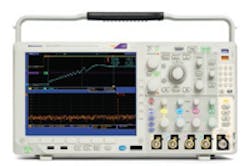Time-domain analysis via an oscilloscope and frequency-domain analysis with a spectrum analyzer are often performed on the same design/test bench. Now, with the new MDO4000 Mixed Domain Oscilloscopes (MDOs) from Tektronix, both analyses can be executed with the same instrument. This greatly speeds the analysis of a wide range of signals.
It is not surprising that a company like Tektronixwith its rich heritage in both analog and digital oscilloscopes, as well as in RF/microwave spectrum analyzerswould seek to combine this variety of measurement functionality into a single compact instrument. The MDO4000 instruments (see figure) split the screen into top (time-domain) and bottom (frequency-domain) halves. This allows operators to study the correlation between different events when analyzing, for example, the frequency-domain response of a voltage-controlled oscillator (VCO) to its digital turn-on command.
The MDO4000 instruments each feature four analog channels, 16 digital channels, and 1 RF/microwave channel. Models are available with analog bandwidths of 500 MHz or 1 GHz, and instruments can be specified with an RF channel bandwidth of 50 kHz to 3 GHz or 50 kHz to 6 GHz. The capture bandwidth for this spectrum-analyzer channel is greater than 1 GHz for all center frequencies, providing generous analysis bandwidth when studying modulated or even frequency-hopped RF and microwave signals. The 16 digital channels each feature 60.6-ps timing resolution. The MDO4000 analyzers are supported by standard passive voltage probes with 3.9-pF capacitive loading and 500 MHz or 1 GHz bandwidth. Signals are shown on a bright 10.4-in. (264 mm) XGA color display. Each analyzer is only 5.8 in. deep and weighs only 11 lbs. (5.5 kg).
It is important to note that these instruments actually provide a separate spectrum-analysis signal path. The spectral displays are from detected front-panel input signals, not from a Fast Fourier Transform (FFT) of signals already analyzed by the oscilloscope portion of the instrument. The MDO4000 instruments are well equipped with connectivity options, with numerous Universal Serial Bus (USB) 2.0 host ports on the front and rear panel and a USB 2.0 device port on the rear panel allowing for easy connectivity to a personal computer (PC). The instruments also include an integrated 10/100/1000BASE-T Ethernet port for network connectivity and offer optional serial triggering for I2C, SPI, USB, Ethernet, CAN, LIN, FlexRay, RS-232/422/485/UART. MIL-STD-1553, and I2S/LJ/RJ/TDM interfaces.
With an MDO4000 instrument, an engineer not only saves space on the test bench, but time in an analysis, essentially being able to perform spectral signal analysis on signals that are also being studied in the time domain with the oscilloscope circuitry. The versatile display makes it possible, for example, to view four decoded serial and/or parallel buses at the same time. The time correlation between analog, digital, and RF domains makes it possible to perform accurate timing measurements on tuning commands versus frequency synthesizer switching speed, for example, or any variety of RF/microwave functions that are activated by analog or digital control signals. The analyzers simplify the analysis of changes in amplitude, frequency, and phase as a function of time, and are ideal for studying such phenomena as settling time and frequency-hop transitions for signal sources with fast switching speeds. The MDO4000 instruments can even use RF power as a trigger source for studying events, using an optional trigger module (model MDO4TRIG). P&A: $19,900 and up.
Tektronix, Inc.,
14150 SW Karl Braun Drive
P.O. Box 500
Beaverton, OR 97077
(800) 833-9200
About the Author
Jack Browne
Technical Contributor
Jack Browne, Technical Contributor, has worked in technical publishing for over 30 years. He managed the content and production of three technical journals while at the American Institute of Physics, including Medical Physics and the Journal of Vacuum Science & Technology. He has been a Publisher and Editor for Penton Media, started the firm’s Wireless Symposium & Exhibition trade show in 1993, and currently serves as Technical Contributor for that company's Microwaves & RF magazine. Browne, who holds a BS in Mathematics from City College of New York and BA degrees in English and Philosophy from Fordham University, is a member of the IEEE.
